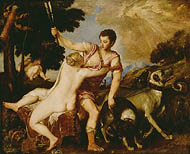Step 1: Ask students to recall one work of art that they remember from their visit. What was its connection to mythology? Have a discussion about other ways the artist could have depicted the same subject. Talk about how there are many ways to visually interpret the same story or idea.
Step 2: Direct students to a passage in their books (or write it on the board) that they have read or are reading in class. Read the passage out loud and tell your students that they are going to make a work of art inspired by this passage. Before they begin drawing, ask each student to write down (or you can have them do this verbally) one or two words that came to mind when they heard/read the passage. Have students share their responses as a group and make a list on the board. Discuss how the passage evoked different responses and how, like artists, they interpreted the same literary work in many ways.
Step 3: Give students paper and drawing materials. Ask them to sketch their ideas for a work of art based on the passage. Remind students that a sketch is a quick preparatory drawing used to help artists record their initial ideas; their piece will not be a finished work and it does not need to be perfect. They can both draw and write on their paper to capture their ideas.
Step 4: Ask the students to share their sketches as a group. Discuss and reflect on how many different ideas were inspired by the same work of literature. Ask students to take another look at the postcards they used in the pre-visit activity. If they were to sketch their god, goddess, or hero would they do it differently? How? Why? |
 |
|
Continue your exploration of European mythology in your classroom. The following are useful resources for developing lessons on this topic.
Books:
Baker, Sorelle, and Donna Rosenberg. Mythology and You: Classical Mythology and Its Relevance in Today's World. NTC/Contemporary Publishing Co, 1992.
Barber, Antonia. Apollo and Daphne: Masterpieces of Greek Mythology, with Paintings from Great Art Museums of the World. Los Angeles: The J. Paul Getty Museum, 1998.
D'Aulaire, Ingri. D'Aulaire's Book of Greek Myths. Garden City, New York: Doubleday, 1962.
Grant, Michael, and John Hazel. Who's Who in Classical Mythology. New York: Oxford, 1993.
Grimal, Pierre. The Penguin Dictionary of Classical Mythology. England: Penguin Books, 1991.
Hagen, Rose-Marie, and Rainer Hagen. What Great Paintings Say, 4 vols. Cologne: Taschen, 1995–2000.
Harris, John, illustrated by Calef Brown. Greece! Rome! Monsters! Los Angeles: J. Paul Getty Trust, 2002.
Harris, Stephen L. Classical Mythology: Images and Insights. Mountain View, Calif.: Mayfield Publishing Co., 2001.
Low, Alice. Greek Gods and Heroes. New York: Maxwell Macmillan, 1994.
Richardson, I. M. The Voyage of Odysseus. Mahwah, New Jersey: Troll Associates, 1984.
Sousa, Jean. Telling Images: Stories in Art. Chicago: Art Institute of Chicago, 1997.
Web sites:
Art History Resources on the Web
A site filled with art historical information from prehistory to the 20thcentury. Links to museum sites and image resources. A great source for information on an artist or genre.
ArtLex—Dictionary of Visual Art
Definitions of over 3,300 terms, thousands of images, pronunciation notes, and links to other resources.
ArtsEdge
Sponsored by the Kennedy Center, ArtsEdge includes lesson plans, units, and other ideas for classroom teaching in the arts.
Minneapolis Institute of the Arts—World Mythology
Explanations of myths, a bibliography of suggested readings, and a glossary of terms used in art.
Tufts University—Perseus Digital Library
An online source for translations of ancient texts from Greece and Rome. |
 |
 |






